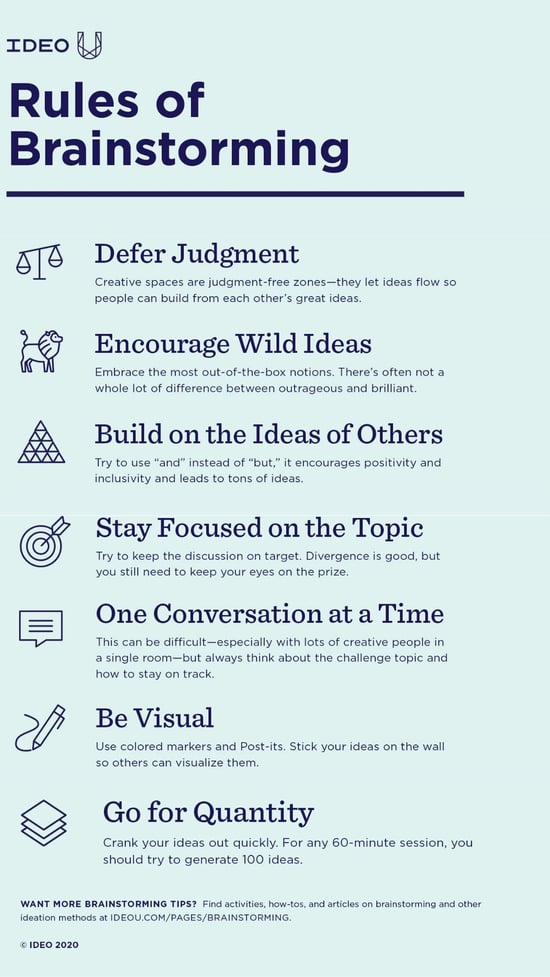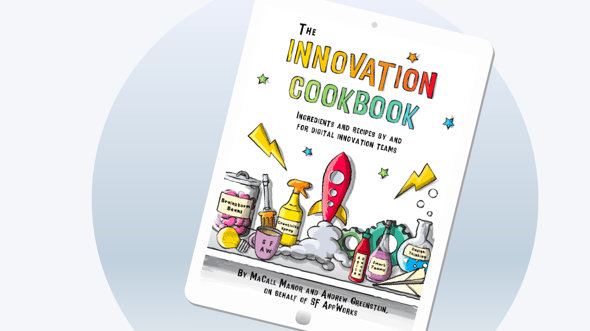Seasoned entrepreneurs and creatives understand that ideas are a dime a dozen. It takes thousands of good ones over the course of a product’s lifecycle to get through the battlefield of failed concepts and misguided initiatives. Sometimes ideas pop out of thin air. Other times they spawn from lessons learned. But to build a reliable pipeline of actionable ideas, you’ll need to harness your team’s collective experience and brain power through brainstorms.
Master the brainstorm and you will have an idea machine at your disposal for when work throws its stickiest challenges at you.
We’ve brainstormed all sorts of ways - with 50 people and with 2, with clients and without, with cross-team expertise and with specialized units. For hours, and for minutes. To great success and to utter frustration. Here’s what we’ve learned.
Related: 3 Dynamic Models of Innovation
9 PROVEN TECHNIQUES TO HELP YOU MASTER THE BRAINSTORM
Right time, right place
If you’re going to be solving problems frequently, consider dedicating a space to brainstorming. Have a whiteboard or place to stick notecards. Make it fun. Throw some quotes on the wall. Keep your laptops and phones at your desks and enter your creative space open-minded and undistracted. This works in the digital world too. Dedicate a space in your home for thinking and join your conference call from there.
Time matters too - if you brainstorm too late in the day, energy and enthusiasm will sputter. What’s worse - any good ideas that are generated at the end of the day can get lost in the evening and won’t show back up to work the next day. But brainstorming too early in the day can also be problematic since people might be preoccupied with other tasks still left to do in their day. We’ve found that late morning and early afternoon brainstorms work the best.
Listen in as we explore the business and technology topics that are transforming our world.
Brainstorm alone, then together
Before you brainstorm together, spend a few minutes preparing. Jot down the first ideas that come to your head, even if they feel obvious or ridiculous. Write down any questions that come to mind. Then write down any assumptions you are making. Take a minute to google and scan some results to see if others have tried solving the same problem. The idea is not to solve the problem ahead of the brainstorm, but to come equipped with fodder to get the idea machine running.
Related: Organizational Models for Managing Innovation
Have the right minds
We’ve discussed the importance of having several minds on your innovation team. Nowhere is this more relevant than in the brainstorm - a task where you analyze problems from all sides to come up with novel solutions that require cross-disciplinary thinking.
Researchers are more likely to have seen how others have solved this problem, testers will be attuned to existing users and data, sellers will have a sense of what can excite people, and designers will have practical solutions on hand. Bring people from different teams and different parts of the organization. Bring people from the top of the organization, and from the bottom, if possible. Bring customers. If you can look at the problem from all the angles, you have a better chance of finding the most impactful solutions.
Get a Free Copy of "The Innovation Cookbook"
In our latest eBook, we share in-depth ideation strategies and tactics on how to integrate a more innovative thinking in your day-to-day life. Get some key innovation tips from product developers, designers, and technologists.
Keep it short
Locking your team in a room until a solution emerges sounds noble, but it’s an inefficient use of creativity. Creativity comes in bursts of intense thinking, followed by reflection, followed by more thinking, followed by more reflection. A short brainstorm of 30-40 minutes is enough to set the premise and explore a few angles. Let the mind go to work in between brainstorming sessions as ideas resonate and evolve.
Bring people back a few hours later, or the following day, for a second or third brainstorm. If the ideas just aren’t there, break and let the team read, discuss, mull, and come back. Time pressure helps - deadlines create focus and provide motivation. Quality pressure is frustrating and saps confidence, making people feel like they’re not bright enough to solve the problem. Short sessions keep things fun and focused.
Define rules
Ideo has a list of rules for brainstorming. Brainstorming is like a game - by creating rules, you teach people how to play the game. Create your own brainstorming rules that fit the tone and style of your team, then communicate those at the beginning of your brainstorm. Invite everyone to help enforce the rules, and don’t be afraid to change or make new ones if you see an opportunity for improvement.

Warm Up
A three-minute creative warmup can loosen then creative muscles and get ideas flowing. One exercise from Experiences in Visual Thinking by Robert McKim is to draw 30 circles on a page. Then, with a few lines inside or outside of each circle, come up with as many recognizable objects as you can.
Another example is the 3-2-1 Blastoff exercise. You stand up and shut your eyes, imaging that you are in an open field with blue skies above. Then you blastoff! Spend 15 seconds imagining yourself flying to the moon and back. Then answer a few questions about your experience:
Did you wear a spacesuit?
Did you land on the moon?
Kids are great at this because they are unconstrained in their imaginations. Adults, on the other hand, struggle to keep an open, judgment-free mind. Exercises like this can loosen the clamps on our exploratory mind.
A final creative exercise to try is called 100 uses. You divide the room into equal-sized groups and pick a random object - like a rubber band or a paper clip. Then each group writes down as many uses as they can think of in a 3-minute period.
There are countless creative exercises to get the juices flowing. Try one of the above or invent your own.
Related: What is Rapid Prototyping?
Start with Questions
Once you’re warmed up and ready to ideate, start by asking questions, the more obvious the better.
Why are we trying to solve this problem?
What happens if we don’t solve this problem?
How does this help our mission goals?
Experiment with the 5 Whys - a great tool for getting to the root of a problem.
Each time you answer a question, ask one more “why?”.
Why are users not making it through the onboarding? Because it’s too long.
Why is it too long? Because we need all that data to create their account and their training plans.
Why do we need all of that data? Because we need the information to create their training plans and accounts, or else their dashboards will be empty when they log in?
Why will their dashboards be empty? Because we don’t have any generic or quick start plans to provide them with in case we don’t have all of their info?
Why don’t we have generic training plans to get them started more quickly? That’s a great question Steve, I’m glad you asked.
Going through 5 ‘whys’ forces you to reframe the problem, over and over, until a possible solution emerges. It also keeps you focused on problem-oriented feature development, which is a great approach to product development.
Asking questions gets people up to speed on the context and history of the problem, and also gets different people in the room sharing thoughts and ideas. Before you know it, people will sprinkle in “what if we…” statements alongside questions.
Change the premise
When you can’t think outside of the box, try thinking inside of another box by changing the premise. Ask yourself - how would we solve this problem if we had a billion dollars. What if we had $1,000? What if we had to solve this problem without desktop computers? What if we were solving it for senior citizens? What if we had to solve this problem in a day? What if we had 1,000 years. Reframing the problem creates easier paths for your mind to follow, and those paths can lead to new and novel solutions.
Related: Insidesource Design Sprint
Just Show Up
Don’t make brainstorms a bigger deal than they are. Sure, they can generate world-changing ideas, but they don’t have to. By keeping your brainstorms short, you lower the cost of having them, which means you can have them more often. Defining the rules and incorporating warmups make it fun and a nice break from the daily grind. Asking why refocuses your team on what matters.
MASTERING TEAM BRAINSTORMING - BEYOND IDEATION
Team brainstorming sessions are used to generate and concept new ideas but, if done properly, the benefits of a brainstorm can extend beyond ideation. Letting ideas flow freely encourages open and ongoing collaboration and acts as a liaison between team members. Moreover, the ideas generated during brainstorming sessions can be later refined and merged to create robust solutions.
Recommendation: Make brainstorms quick, fun, and habitual so that your team looks forward to them and is not intimidated by them. And most importantly, just show up. Invite the team, see who comes, see how it goes, try new things, and then repeat.
.png?%20White%20Bake%20Sale%20Promotion%20Facebook%20Post%20(4).png&width=290&name=Simple%20Pink%20%26%20White%20Bake%20Sale%20Promotion%20Facebook%20Post%20(4).png?%20White%20Bake%20Sale%20Promotion%20Facebook%20Post%20(4).png)






COMMENTS